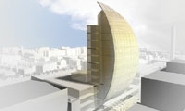An ambitious masterplan for the University of Bristol’s main precinct has been adopted by Bristol City Council following months of preparation, debate and community involvement.
The plan will guide the physical development of the Tyndall Avenue area over the next 20 years, underpinning the university’s efforts to strengthen its global position as a centre for leading-edge research and education. The university has recently been independently ranked seventh out of 109 UK universities and 49th out of thousands of universities across the world.
The university is not planning to increase undergraduate numbers, but it does want to raise the standard of facilities for teaching, learning and social activities. It also intends to create more and better research space and to upgrade the overall physical environment for students, staff and the public. It is keen to improve public access through the university, conserve historic buildings fronting St Michael’s Hill and enhance important landscapes such as Royal Fort Gardens.
Professor Eric Thomas, the university’s Vice-Chancellor, said: “The city council’s adoption of the masterplan is wonderful news for us, but it will also lead to important economic, social and environmental benefits for the city and the region.”
He added that the university would be investing about £300 million over the next six years, mainly in buildings, facilities and enhancements to open spaces and transport and access arrangements. “Not only will we create some of the best academic resources in the world,” he said, “but we will also transform our main precinct area into something much more attractive for the community as a whole.”
The masterplan was drafted following an extensive community engagement programme involving discussions with interested residents and groups, and was then further revised in the light of comments arising from a six-week public consultation period. It was agreed by the city council’s Cabinet at its meeting on Thursday, July 13.
Councillor Barbara Janke, Leader of Bristol City Council, said: “The university plays a vital role in the economic and cultural life of the city. Having a world-class university is a huge advantage for Bristol and its success is integral to Bristol’s status as a great British and international city.
“By agreeing this masterplan in partnership with the university, we are setting a framework for future planning decisions that promotes and supports the university’s important work while protecting and enhancing the local built environment and being sensitive to the concerns and needs of local communities.”
The university will still have to submit detailed planning applications for each new development within the precinct. The planning policies adopted by the city council together with the new masterplan will provide the framework and parameters against which proposals will be judged.
Subjects of future planning applications will include new Biological Sciences and Mathematics departments on the former Children’s Hospital site in St Michael’s Hill and a new complex in Tyndall Avenue incorporating a major library and students’ union building.
The area covered by the plan stretches from Cotham Hill down to Park Row and from Priory Road/Elton Road and University Road across to St Michael’s Hill.
Work on the masterplan was co-ordinated by the university’s Estates team in partnership with the city council’s planning team; project managers Northcroft; architects Feilden Clegg Bradley; consultants CSJ Planning; and many more.*
Julie Laming, Associate Director of CSJ Planning, said: "The masterplan has been a challenging but immensely exciting project to work on, especially as we too are based in Bristol. The plan is important not only to secure the future success of the university but also in terms of the aesthetic, economic and environmental benefits it can deliver to Bristol as a whole."
